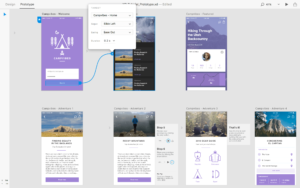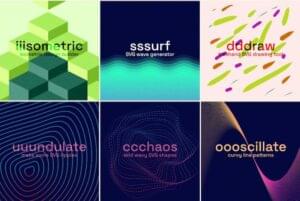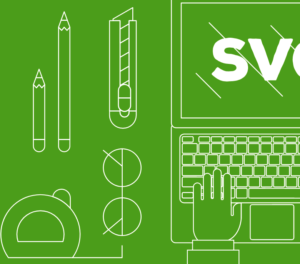Have you ever worked with HTML from Microsoft Word’s ‘Save as a Webpage‘ feature?
Ouch. It’s painful.
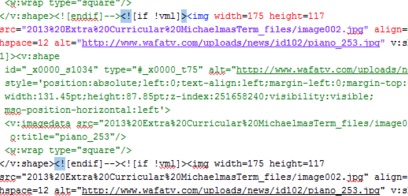
It should have been a miracle feature but if you ever had to work with the generated HTML source, you probably spat your coffee when you first saw it. It was always crazily convoluted and horribly bloated – really bad qualities for the web.
And to be fair, that’s not a huge surprise either.
Let’s face it: people using MS Word probably aren’t concentrating on what works best on the web. They are using Word – why would they care about:
- page load times?
- web image formats?
- semantics & SEO?
- changable screen sizes (responsive design)?
- font availability?
So it’s hardly surprising that an after-thought conversion process generates obese, deranged HTML, right?
Is SVG the new ‘Save as Webpage”?
Today SVG is hot. You’ll find ‘Save as SVG‘ in most of the big name graphics applications including Photoshop, Sketch, Illustrator and Inkscape and this is generally a good thing.
But there is a risk of similar ‘Word-to-HTML’ conversion issue emerging. Software makers are competing to make the best, most powerful graphics tool they can. That might require jamming in 3D modeling interfaces, perspective transformers, bevels, font generators, and other ‘gee-whizz’ tricks.
So, exporting the final output to SVG becomes a problem to solve at the end of the process – like Word does with HTML.
That’s great for design freedom, but not great for making the most of SVG. So sometimes it’s better to have a simpler tool that only gives you access to the things SVG is good at.
What is SVG Good at?
SVG has a bunch of features that are super-useful on the web. These include:
- Mathematical control: SVG is an efficient, plain-speaking shape & layout language, which makes it easy to manipulate in your code editor.
- Symbols: A little bit like CSS. Define a graphic once – call on it as often as you like.
- Patterns: As with CSS tiling backgrounds, a great way to use small graphics to cover large areas.
- Masks: SVG can mask with hard vector shapes or softer alpha channel masks.
- Blend Modes/Channels: As with Photoshop, SVG letters you change how overlapping layers interact with each other – darken, hard light, color dodge etc.
Meet Boxy SVG
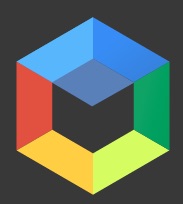
Boxy SVG is a FREE simplified vector editor – running as a Chrome App – designed to give you full access to precisely the features that SVG is good at.
Now I don’t want to do a comprehensive review here – you know what a vector editor does – but I want to touch on a few features I really like about it.
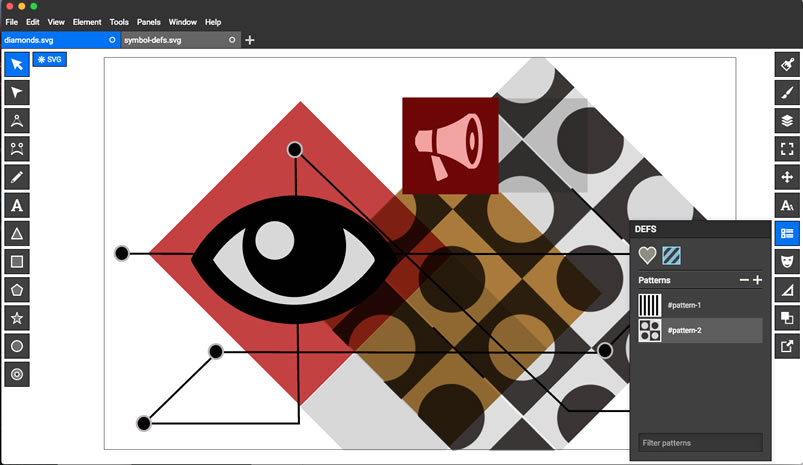
Basic Drawing Tools
![]()
As you would expect, Boxy comes with a range of vector creation tools – pens, bezier curves, text, and the basic shapes provided in SVG (rectangles, circles, triangles etc).
The Panels on the right are probably the more interesting menus.

In order, they control:
- Fill
- Stroke
- Compositing (layers)
- View (document size, setup)
- Arrangement (alignment, transforms, Z order)
- Typography (including font, size & type on a path)
- Defs (reusable resources like patterns & symbols)
- Masks (Vector and alpha)
- Geometry (position, size & rotation)
- Path (convert to path, unite, subtract etc)
- Export (to PNG if you want)
Stroke & Fill
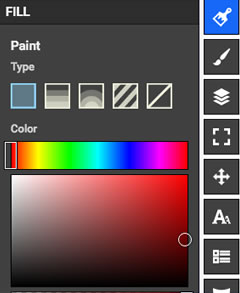
Along with the predictable color pickers and gradient controls, Boxy offers a pretty cool ‘pattern-fill’ option – that’s the stripey box. Clicking the pattern box will open the DEFS panel, where the patterns are stored.
The DEFS Panel
Perhaps the single coolest thing about the SVG format is the concept of ‘definitions’ or <defs>. This is a section at the top of your SVG document where you can define reusable resources like Symbols and Patterns.
It’s a little like a <style> block for graphic elements. Boxy SVG makes it very easy to create, manage and reuse your Symbols and Patterns. Here’s what it looks like in Boxy.
Symbols: Select any graphic that you have created, hit the ‘+’ button on the Symbols menu and you’ll see it instantly appear in the Symbols panel.
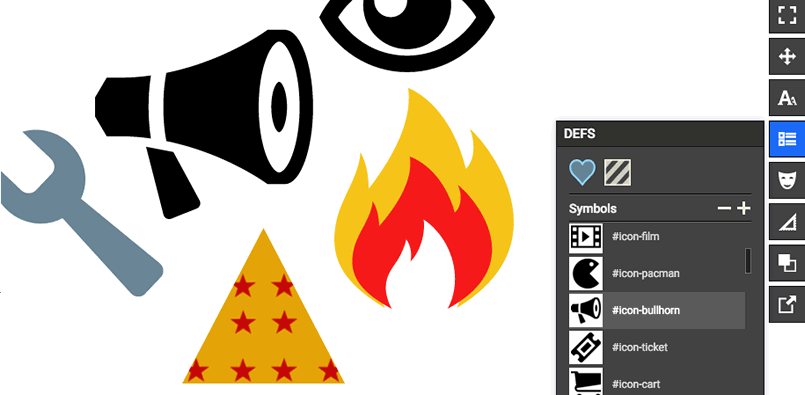
I also found that if you create an SVG icon set at IcoMoon and then open it in Boxy SVG, you’ll see all your icons appear in the Symbols menu. Even if you delete them from the main document view, you’ll still find them in the DEFS panel.
Patterns: Hit ‘+’ on the Patterns menu and you’ll be given a new canvas to create your pattern in. When you’re finished, you’ll find your new pattern ready to use in the FILL and STROKE panels.
The COMPOSITING Panel
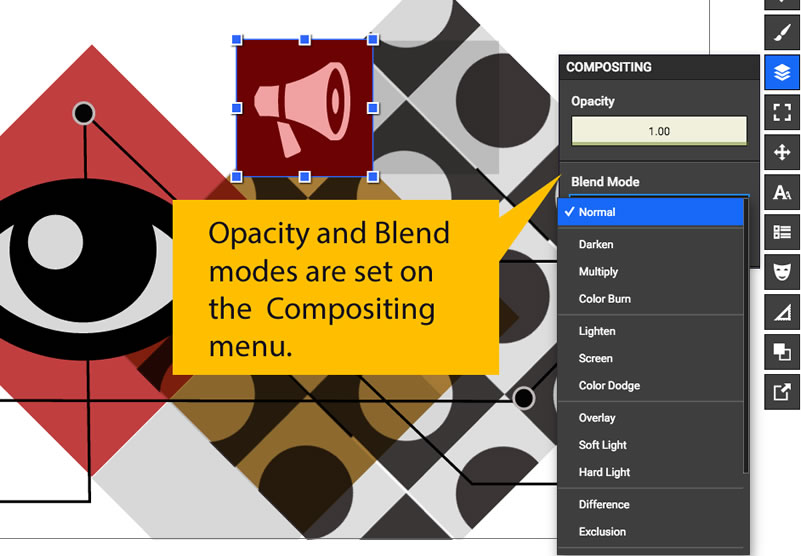
Blend modes are well-supported in SVG and allow your vector shapes to interact in much more ‘Photoshoppy‘ ways. Select a shape and switch the dropdown to experiment with Darken, Multiply, Color Burn, Difference, Hard Light and all your familiar Photoshop faves.
The MASKS Panel
Masking is another of SVG’s super-powers and useful in countless design applications. Just create a mask shape in front of your image, select both, and hit ‘Clip’ in the MASK menu to activate the mask.
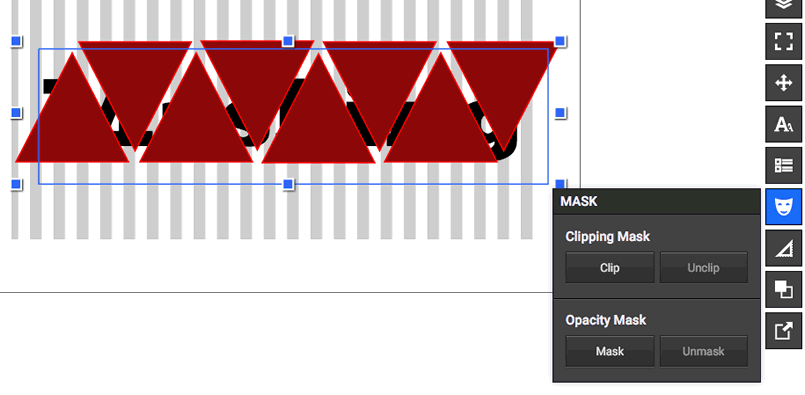
There’s plenty more in BoxySVG, including nice Typography controls and a Pathfinder tool but I don’t want to write 2000 words here. I recommend you have a play and see what you think. It won’t cost you anything but time.
But I Have a Vector Application that Exports SVG. Why Would I Use This?
I think there are two good reasons for checking out Boxy SVG.
1). Firstly, by limiting the UI options, Boxy helps you get a feel for what SVG is good at. You’ll start to plan better web icons, infographics and charts with that knowledge.
2). Secondly, Boxy SVG writes neat, efficient, readable SVG. If you’re comfortable with HTML, open your SVG file in your favorite text editor and you should see a well-structured, neat file you can understand.
Now start adding your own CSS classes to your SVG elements and a <style> block at the top and you’ve got something more powerful. It’s now easy to add in your own hover-effects, CSS transitions, and animations.
Remember, try to keep your artwork relatively simple to start with so you’ll have no trouble understanding the code you’re seeing. There are many tools with more impressive feature sets, but not with more impressive SVG.
Currently, the only major SVG feature that doesn’t seem to be available in Boxy is the ability to apply SVG filters like blurs or color tints. However, since you have access to the code, hand-coding filters into your SVG document isn’t a huge deal (and you’ll learn cool stuff).
The simplicity IS the killer feature here.
Again, this application is 100% free and with no ads. I’m not sure why, but gift horses, right?
To me, Boxy SVG isn’t so much a ‘vector editor that exports SVG’ – it’s more of a WYSIWYG UI for the SVG language.
That’s a subtle difference but I think an important one.
Frequently Asked Questions (FAQs) about Boxy SVG Editor
What are the key features of Boxy SVG Editor?
Boxy SVG Editor is a powerful tool designed to create and edit SVG files. It offers a wide range of features including a user-friendly interface, a robust set of drawing tools, and the ability to import and export files in various formats. It also supports layers, gradients, patterns, and complex path operations. Additionally, it provides a library of SVG elements and templates for quick and easy design creation.
Is Boxy SVG Editor free to use?
Boxy SVG Editor is not entirely free. While it does offer a free version with limited features, to access the full range of tools and capabilities, you need to purchase the premium version. The premium version offers more advanced features and functionalities, making it a worthwhile investment for professionals and serious hobbyists.
How does Boxy SVG Editor compare to other SVG editors?
Boxy SVG Editor stands out from other SVG editors due to its simplicity and efficiency. It offers a clean, intuitive interface that is easy to navigate even for beginners. Despite its simplicity, it doesn’t compromise on features, offering a comprehensive set of tools for creating and editing SVG files. It also supports a wide range of file formats for import and export, making it a versatile tool for various design tasks.
Can I use Boxy SVG Editor on multiple devices?
Yes, Boxy SVG Editor is a cross-platform tool, meaning you can use it on various devices including Windows, Mac, Linux, and Chrome OS. This makes it a convenient tool for users who work on different devices or platforms.
Does Boxy SVG Editor require any special hardware or software?
No, Boxy SVG Editor does not require any special hardware or software. It is a lightweight tool that runs smoothly on most modern devices. All you need is a device with a web browser and an internet connection to use Boxy SVG Editor.
How can I learn to use Boxy SVG Editor?
Boxy SVG Editor is designed to be user-friendly and easy to learn. It offers a range of tutorials and guides to help users get started. Additionally, there are numerous online resources and communities where you can find tips, tricks, and advice on using Boxy SVG Editor.
Can I use Boxy SVG Editor for commercial projects?
Yes, you can use Boxy SVG Editor for commercial projects. The premium version of the tool provides a commercial license, allowing you to use it for both personal and commercial projects.
Does Boxy SVG Editor support collaboration?
Currently, Boxy SVG Editor does not support real-time collaboration. However, you can easily share and export your SVG files for others to view or edit.
What kind of customer support does Boxy SVG Editor offer?
Boxy SVG Editor offers customer support via email. They also have a comprehensive FAQ section on their website where you can find answers to common questions and issues.
How often is Boxy SVG Editor updated?
Boxy SVG Editor is regularly updated to introduce new features, fix bugs, and improve performance. These updates ensure that the tool remains reliable and up-to-date with the latest design trends and technologies.
 Alex Walker
Alex WalkerAlex has been doing cruel and unusual things to CSS since 2001. He is the lead front-end design and dev for SitePoint and one-time SitePoint's Design and UX editor with over 150+ newsletter written. Co-author of The Principles of Beautiful Web Design. Now Alex is involved in the planning, development, production, and marketing of a huge range of printed and online products and references. He has designed over 60+ of SitePoint's book covers.



